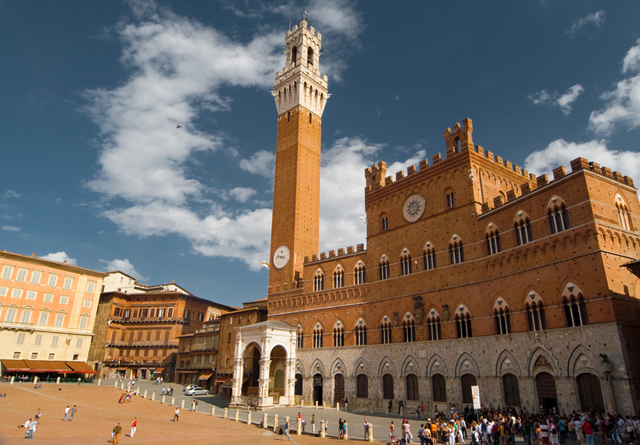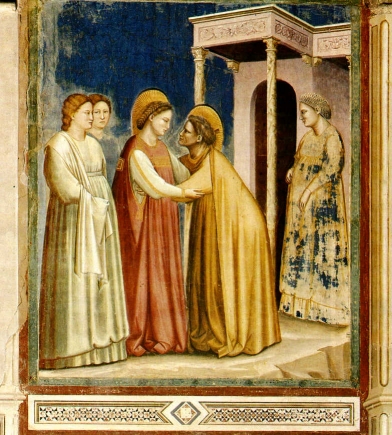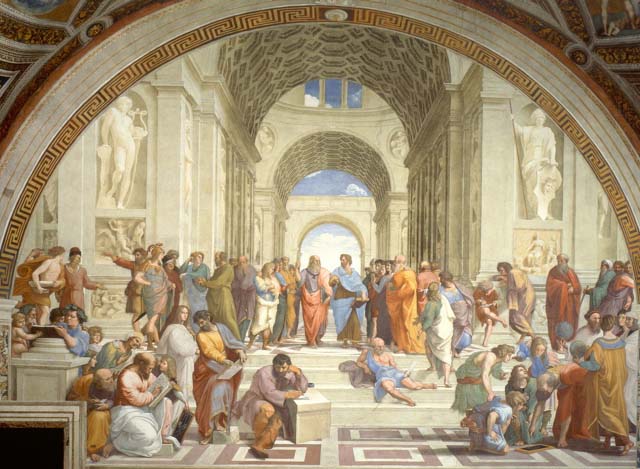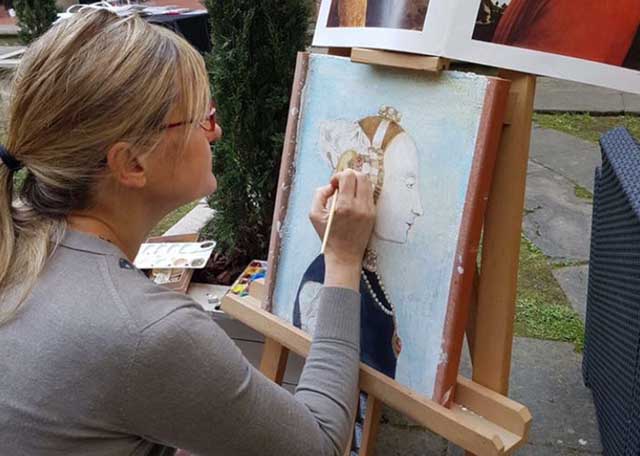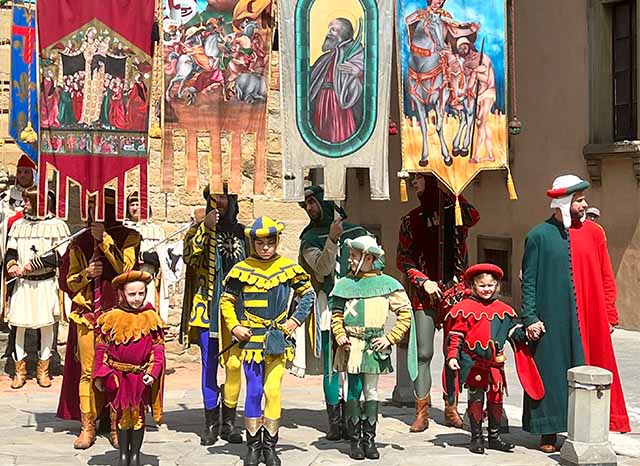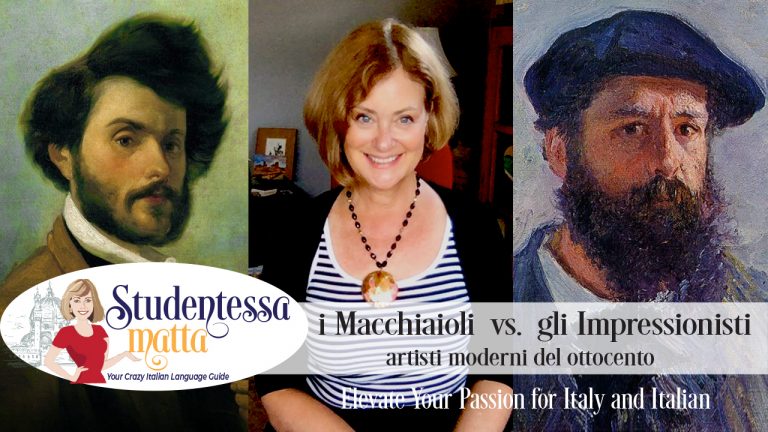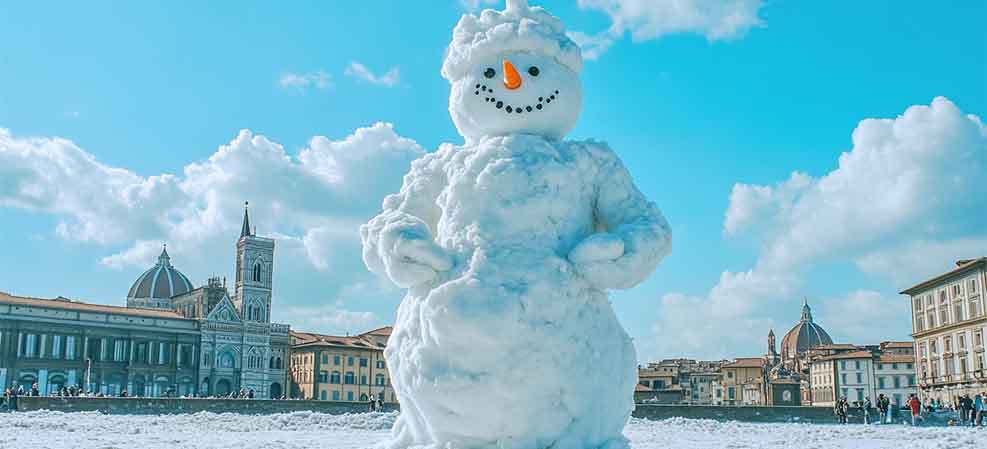
Il Pupazzo di Neve di Michelangelo: Il Capolavoro Più Fresco di Firenze!
Michelangelo’s Snowman: The Coolest Masterpiece in Florence!
Michelangelo’s Snowman and My €5 Journey to Florence
Who made the best snowman of all time?
Qual è più difficile da credere: che Michelangelo abbia scolpito un uomo nella neve e nel ghiaccio, o che io abbia esplorato Firenze per soli 5 euro? Sorprendentemente, entrambe le cose sono vere! Domenica scorsa, nel pomeriggio, mi sono unita a un piccolo gruppo di viaggiatori virtuali per approfondire le incredibili opere di Michelangelo che arricchiscono Firenze. Il tour, intitolato “Quando il marmo prende vita: Michelangelo, scultore fiorentino,” è stato sponsorizzato da PartecipArt e guidato con maestria dalla storica dell’arte Francesca Bozzetto su Zoom.
Which is harder to believe: that Michelangelo carved a man out of snow and ice, or that I explored Florence for just €5? Amazingly, both are true! Last Sunday afternoon, I joined a small group of virtual travelers to delve into the incredible works of Michelangelo that grace Florence. The tour, titled “When Marble Comes to Life: Michelangelo, Florentine Sculptor,” was sponsored by PartecipArt and expertly led by art historian Francesca Bozzetto via Zoom.
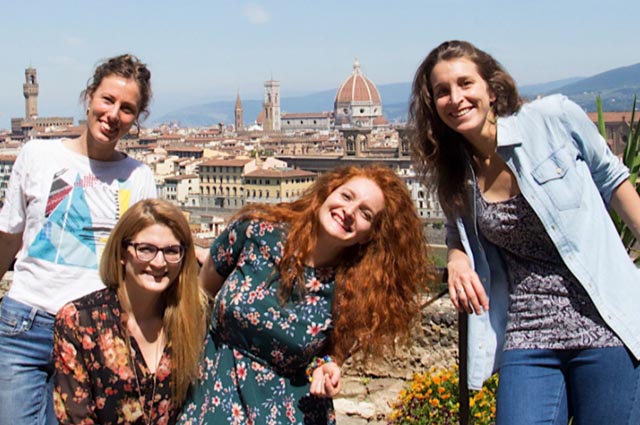
PartecipArt Un’esperienza artistica dinamica e interattiva!
PartecipArtA Dynamic and Interactive Art Experience!
La visita è stata organizzata da PartecipArt e guidata da Francesca Bozzetto su Zoom. Il tour, intitolato “Quando il marmo prende vita: Michelangelo scultore fiorentino,” ci ha fatto immergere nell’arte di Firenze in modo vivace e innovativo.
The tour was hosted by PartecipArt and led by Francesca Bozzetto on Zoom. Titled “When Marble Comes to Life: Michelangelo, Florentine Sculptor,” it brought Florence’s art to life in a fresh, engaging way.
Trovo molto interessante l’idea alla base di PartecipArt, poiché, come loro, credo che l’arte e la storia dell’arte non siano solo un argomento arido e noioso. Invece, il mondo dell’arte è pieno di artisti affascinanti, passione, storie intriganti e persino drammi! Ecco perché scrivo I miei libri ambientati in Italia. Questo è il motivo per cui queste donne condividono la loro passione con il mondo in persona e on-line.
I find the idea behind PartcipArt to be very interesting, as, like them, I believe art and art history aren’t just a dry, dusty subject. Instead, the world of art is full of fascinating artists, passion, intriguing stories, and even drama! That is why I write my books set in Italy. That is why they share their passion with the world in person and online.

Michelangelo e il Pupazzo per Piero Medici
Michelangelo and Piero Medici’s Snowman
Sapevi che, a 19 anni, Michelangelo scolpì un pupazzo di neve per Piero il Fatuo, figlio di Lorenzo il Magnifico? Durante una nevicata eccezionale a Firenze nel gennaio 1494, Piero commissionò a Michelangelo un’opera straordinaria.
Did you know that at 19, Michelangelo sculpted a snowman for Piero the Unfortunate, Lorenzo de’ Medici’s son? During a rare snowstorm in January 1494, Piero commissioned Michelangelo to create something extraordinary.
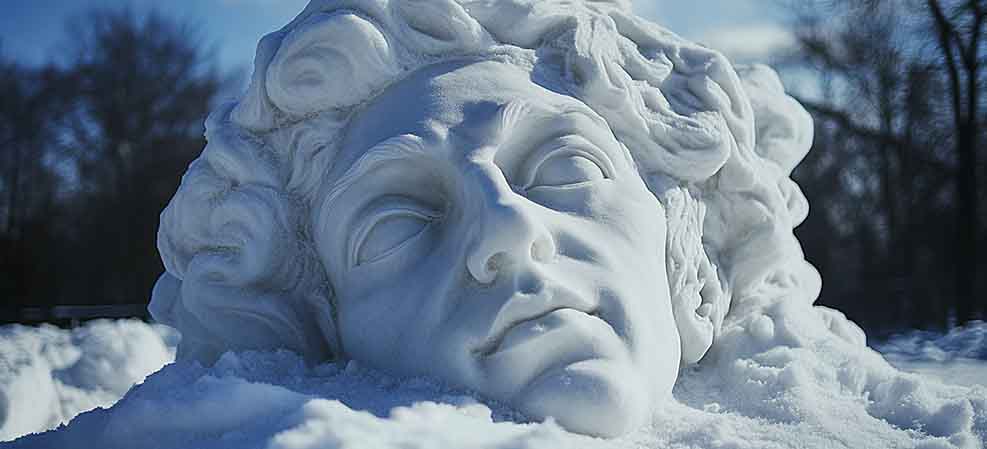
Dopo la morte di Lorenzo il Magnifico, il potere passò a suo figlio Piero, soprannominato “Piero il Fatuo” (Piero lo Sfortunato). Senza il mecenatismo di Lorenzo né un posto alla corte medicea, il giovane Michelangelo fu costretto a tornare a casa del padre Lodovico. Quest’ultimo, frustrato dal fallimento del figlio, lo accolse a malincuore, lasciando Michelangelo umiliato e incerto sul suo futuro: troppo grande per tornare dal suo maestro Ghirlandaio, ma troppo giovane per avviare la propria carriera.
After Lorenzo il Magnifico’s death, power passed to his son, Piero, nicknamed “Piero il Fatuo” (Piero the Unfortunate). Without Lorenzo’s patronage or a place at the Medici Court, the young Michelangelo had to return to his father Lodovico’s house. Lodovico, frustrated with his son’s lack of success, reluctantly took him in, leaving Michelangelo humiliated and uncertain about his future—too old to return to his master Ghirlandaio, yet too young to strike out on his own.
Poi, il 20 gennaio 1494, una rara nevicata ricoprì Firenze. Per celebrare l’evento, Piero commissionò a Michelangelo la creazione di un pupazzo di neve—ma non un pupazzo qualsiasi. Doveva essere il più magnifico mai realizzato. Inizialmente poco entusiasta, Michelangelo si rese presto conto che quell’incarico poteva offrirgli l’opportunità di rientrare nelle grazie dei Medici. Accettò la sfida e scolpì una statua di Ercole alta quasi due metri, che lasciò i fiorentini a bocca aperta.
Then, on January 20, 1494, a rare snowstorm blanketed Florence. To mark the occasion, Piero commissioned Michelangelo to sculpt a snowman—but not just any snowman. It was to be the most magnificent ever made. Initially unenthusiastic, Michelangelo soon recognized the opportunity to regain favor with the Medici and took on the challenge, crafting a nearly 2-meter-tall statue of Hercules that amazed all of Florence.
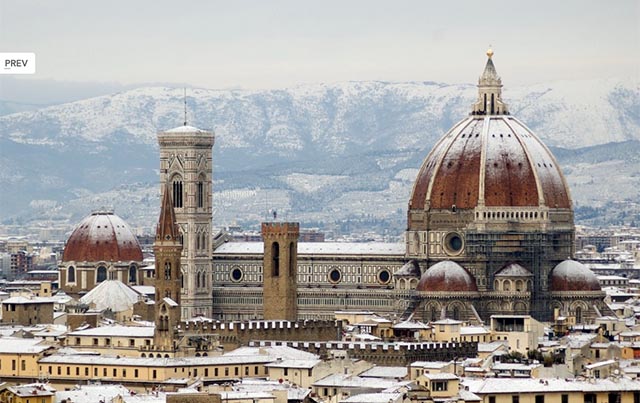
Il pupazzo di neve rimase esposto nei Giardini Medicei di Via Larga per otto giorni prima di sciogliersi, ma l’impatto fu duraturo. Affascinato dall’opera, Piero invitò Michelangelo a tornare al Palazzo Medici, ripristinando il suo posto a corte.
The snowman stood proudly in the Medici Gardens on Via Larga for eight days before melting, but its impact was lasting. Captivated by the masterpiece, Piero invited Michelangelo back to the Medici Palace, restoring his place at court.
Grazie a questa insolita commissione, Michelangelo ritrovò importanti mecenati e continuò a lavorare per i Medici, creando in seguito capolavori immortali come il David, custodito nell’Accademia di Firenze (con una copia esposta davanti a Palazzo Vecchio).
Thanks to this unique commission, Michelangelo regained influential patrons and continued working for the Medici—eventually creating timeless masterpieces like the David, housed in Florence’s Accademia (with a copy outside the Palazzo Vecchio).
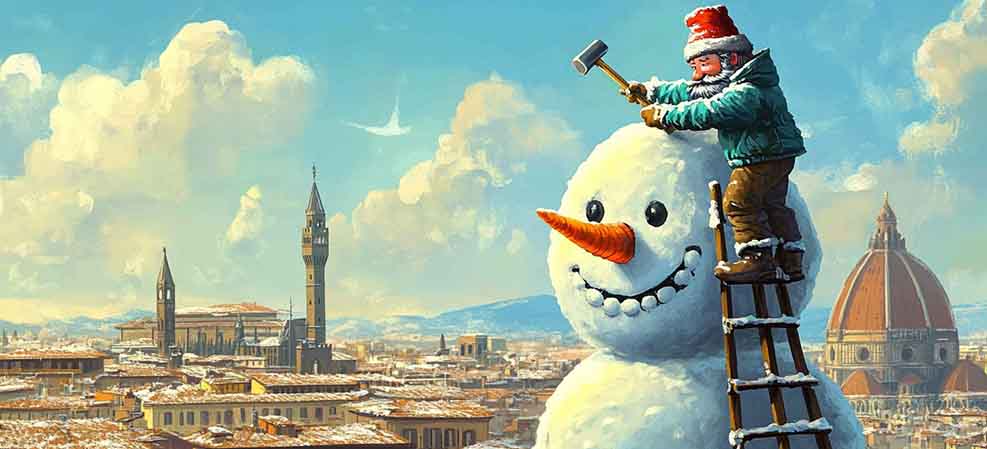
Un tributo finale toccante
A Touching Final Tribute
Una delle ultime sculture monumentali di Michelangelo realizzate quando aveva ben oltre i 70 anni fu La Deposizione (una scena che raffigura un momento tenero dopo la rimozione di Cristo dalla croce.) L’opera è ora al Museo dell’Opera del Duomo di Firenze. Nicodemo, l’uomo dietro Maria, che reggeva l’inerte corpo di Cristo, ero uno scultore che scolpiva le visioni che Dio gli aveva mandato.
One of Michelangelo’s last monumental sculptures made when he was well into his 70s was The Deposition (a scene depicting a tender moment after Christ’s removal from the cross). The piece is now in the Museo dell’Opera del Duomo in Florence. Nicodemos, the man who stands behind Mary, supporting the limp body of Christ, was a sculptor who carved the visions God sent him.
È interessante sapere che Michelangelo diede a Nicodemo il suo viso, così in effetti è l’ultimo autoritratto di Michelangelo. Ma ancora, è un tribute straziante, poiché Vasari, amico di Michelangelo, ha scritto che l’artista era profondamente scoraggiato dalle sue capacità fallimentari, dall’estrema durezza del marmo e dalla malinconia della vecchiaia, che ha attaccato il statua in un impeto di frustrazione, rompendo così il braccio sinistro di Cristo in due punti.
It is interesting to learn that the sculptor gave Nicodemus his features, so in effect, it is Michelangelo’s last self-portrait. But still, it is a heartbreaking tribute, as Vasari, Michelangelo’s friend, has written that the artist was deeply discouraged by his failing abilities, the extreme hardness of the marble, and by old age melancholy, that he attacked the statue in a fit of frustration, thus break the left arm of Christ in two places.
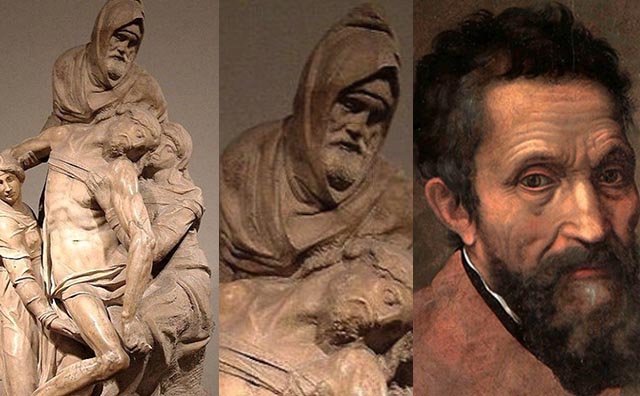
Unisciti a PartecipArt!
Join PartecipArt!
Se vuoi scoprire più storie affascinanti su Michelangelo e l’arte di Firenze, partecipa al prossimo tour virtuale delle donne di PartecipArt. Segui il link sottostante per acquistare il tuo biglietto su Eventbrite per soli 5 euro!
Want to learn more about Michelangelo and Florence? Join the next virtual tour by the PartecipArt team. Click the link below to get your Eventbrite ticket for just €5!
